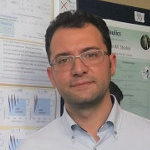Magnetoelastic Effects
A special issue of Magnetochemistry (ISSN 2312-7481). This special issue belongs to the section "Magnetic Nanospecies".
Deadline for manuscript submissions: closed (1 August 2021) | Viewed by 3526
Special Issue Editors
Interests: pattern formation and stability; parabolic and hyperbolic reaction-advection-diffusion models; mathematical biology and ecology; population dynamics
Special Issues, Collections and Topics in MDPI journals
Interests: Mathematical modelling of magnetization and spin-wave dynamics; magnetoelasticity and magnetostriction; pattern formation and stability; parabolic and hyperbolic reaction-advection-diffusion models; mathematical biology and ecology.
Interests: Linear and nonlinear dynamics of magnetic excitations in magnetic films, multilayers, and finite-size samples: spin waves, solitons, parametric instabilities; applications of linear and nonlinear spin waves in microwave signal processing.
Special Issue Information
Dear Colleagues,
This Special Issue aims to provide a valuable forum where scientists of different backgrounds (mathematicians, physicists, engineers and chemists) will be able to share their most recent novel, theoretical and/or experimental, findings on magnetoelastic effects.
Topics to be covered include (but are not limited to):
- Mathematical modeling, numerical simulations and experiments on magnetoelastic effects;
- Magnetoelastic effects in connection with the symmetry of crystals;
- Physical effects caused by the interaction of electromagnetic and mechanical phenomena: voltage-controlled magnetic anisotropy in magnonic and spintronics devices; magnetoelastic and thermal effects in magnonic-phononic crystals; strain-controlled devices based on multiferroic and multifunctional materials (such as hybrid piezoelectric-ferromagnetic and piezoelectric-antiferromagnetic layered structures);
- Topological Structures and magnetization dynamics in multiferroic and multifunctional materials: high-frequency nanoscale spin-wave generation, domain wall motion, dynamics of vortices and skyrmions;
- Micro- and nano-mechanical applications: sensors, actuators, storage, information and communication technology devices.
Prof. Dr. Giancarlo Consolo
Prof. Giovanna Valenti
Prof. Andrei Slavin
Guest Editors
Manuscript Submission Information
Manuscripts should be submitted online at www.mdpi.com by registering and logging in to this website. Once you are registered, click here to go to the submission form. Manuscripts can be submitted until the deadline. All submissions that pass pre-check are peer-reviewed. Accepted papers will be published continuously in the journal (as soon as accepted) and will be listed together on the special issue website. Research articles, review articles as well as short communications are invited. For planned papers, a title and short abstract (about 250 words) can be sent to the Editorial Office for assessment.
Submitted manuscripts should not have been published previously, nor be under consideration for publication elsewhere (except conference proceedings papers). All manuscripts are thoroughly refereed through a single-blind peer-review process. A guide for authors and other relevant information for submission of manuscripts is available on the Instructions for Authors page. Magnetochemistry is an international peer-reviewed open access monthly journal published by MDPI.
Please visit the Instructions for Authors page before submitting a manuscript. The Article Processing Charge (APC) for publication in this open access journal is 2200 CHF (Swiss Francs). Submitted papers should be well formatted and use good English. Authors may use MDPI's English editing service prior to publication or during author revisions.
Keywords
- magnetoelasticity
- magnetostriction
- crystal symmetry
- multiferroic and multifunctional materials
- strain-controlled devices.
Benefits of Publishing in a Special Issue
- Ease of navigation: Grouping papers by topic helps scholars navigate broad scope journals more efficiently.
- Greater discoverability: Special Issues support the reach and impact of scientific research. Articles in Special Issues are more discoverable and cited more frequently.
- Expansion of research network: Special Issues facilitate connections among authors, fostering scientific collaborations.
- External promotion: Articles in Special Issues are often promoted through the journal's social media, increasing their visibility.
- Reprint: MDPI Books provides the opportunity to republish successful Special Issues in book format, both online and in print.
Further information on MDPI's Special Issue policies can be found here.







